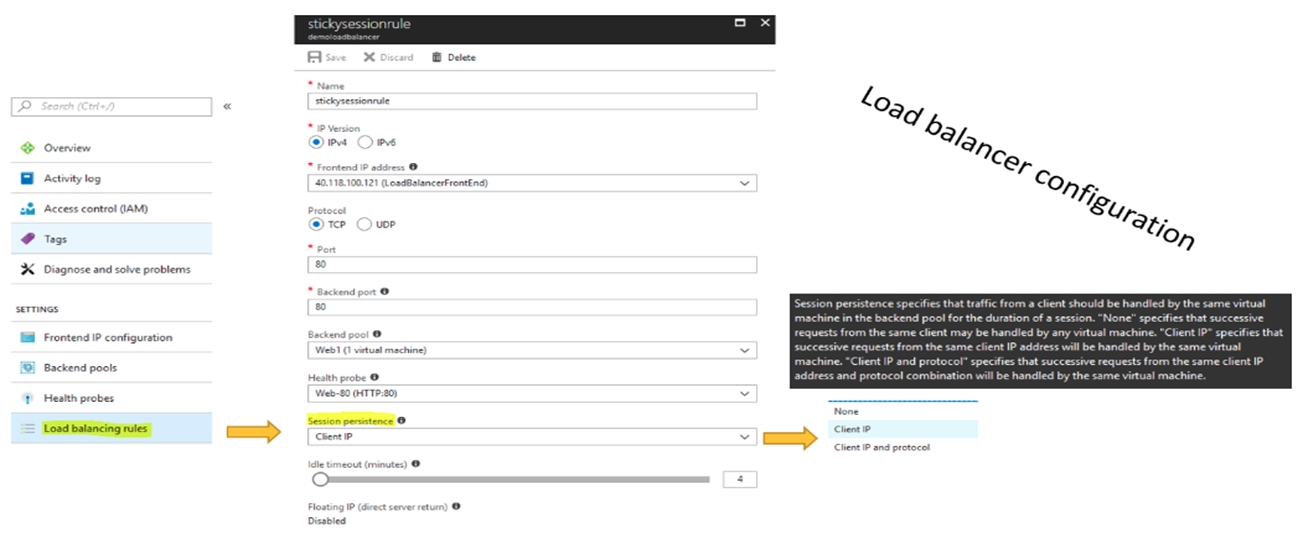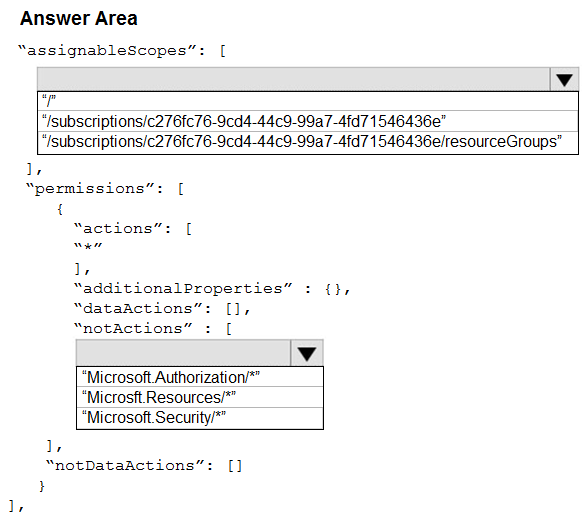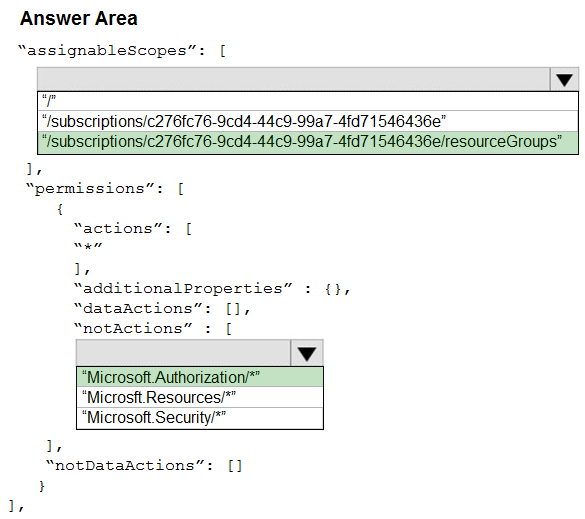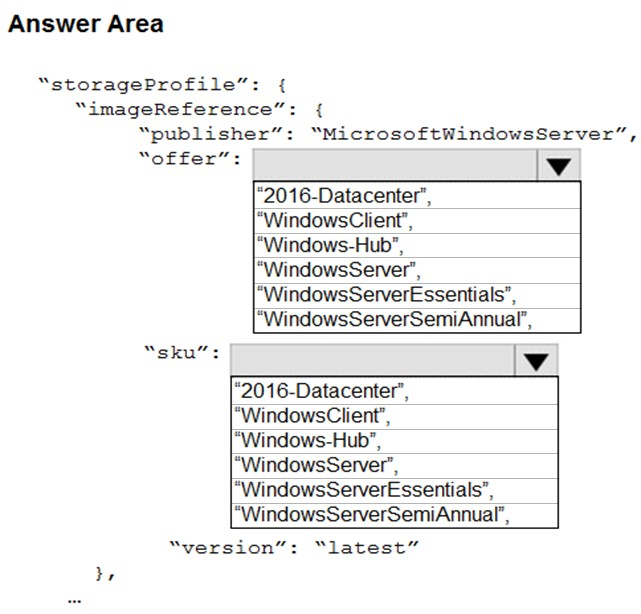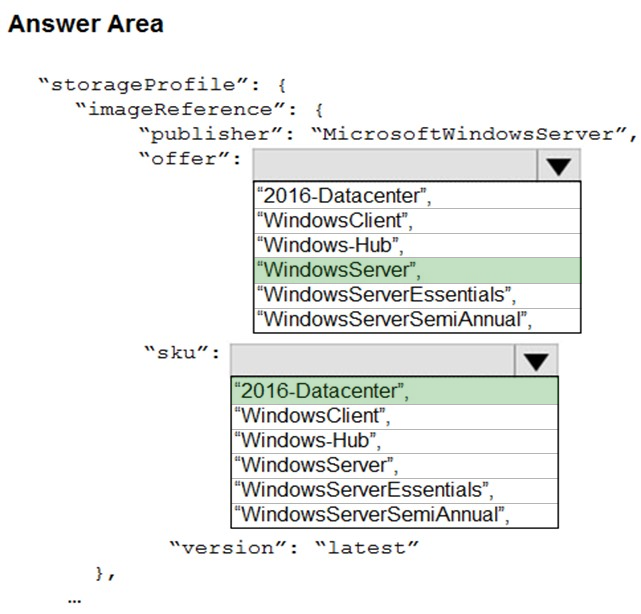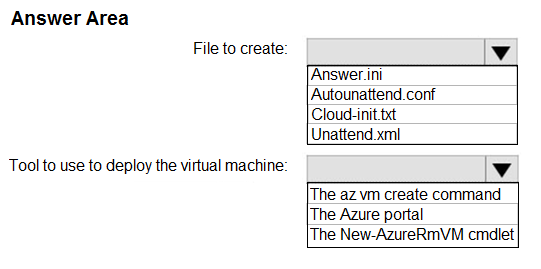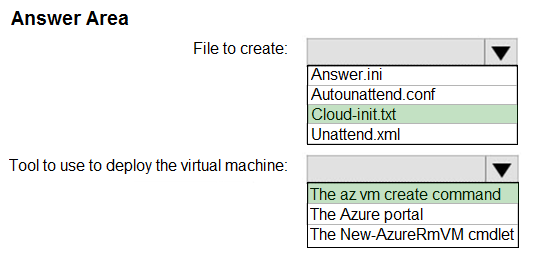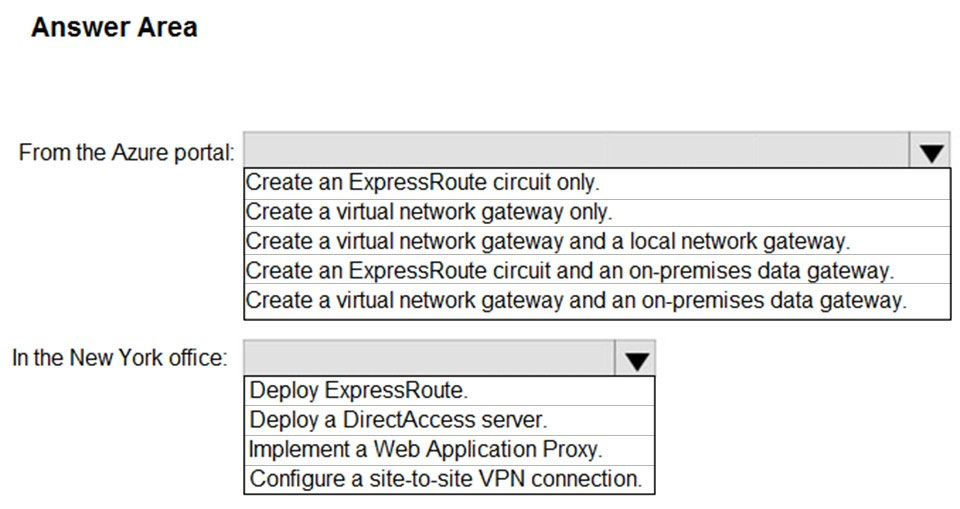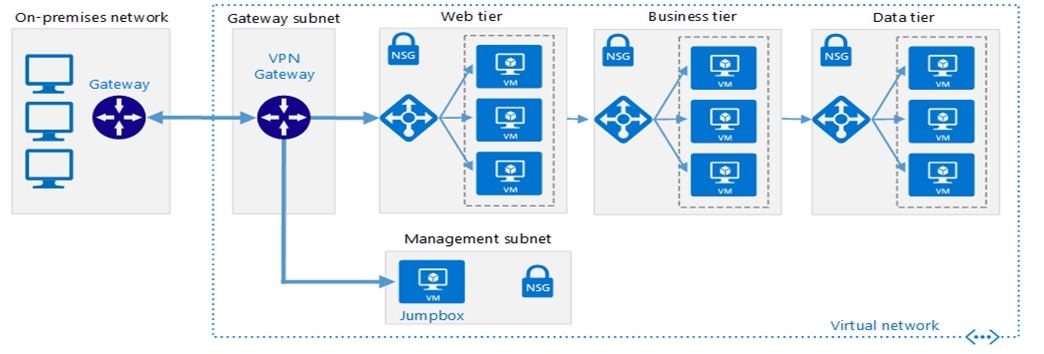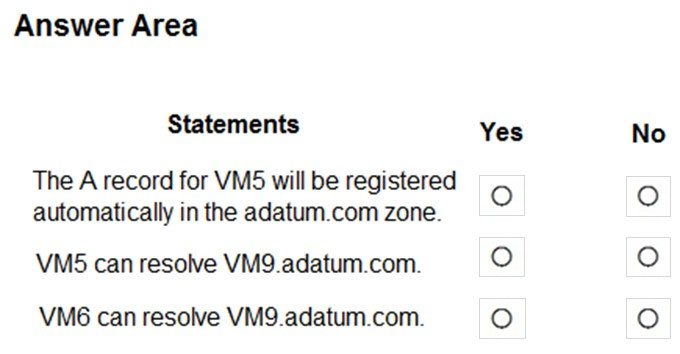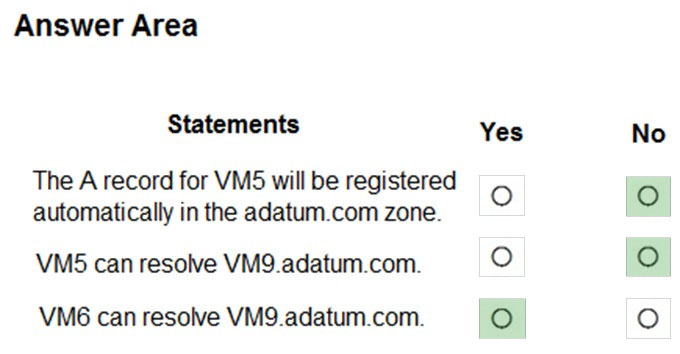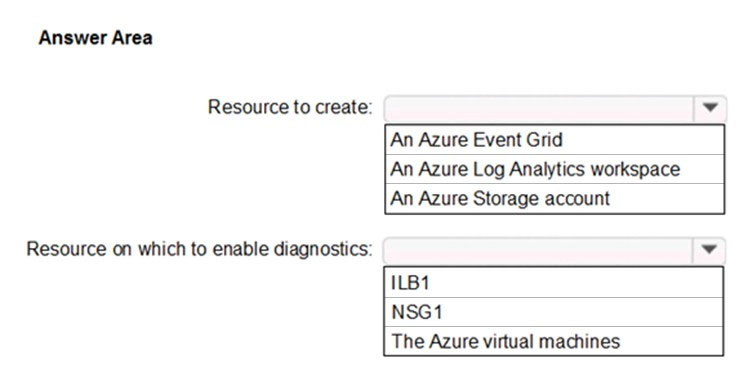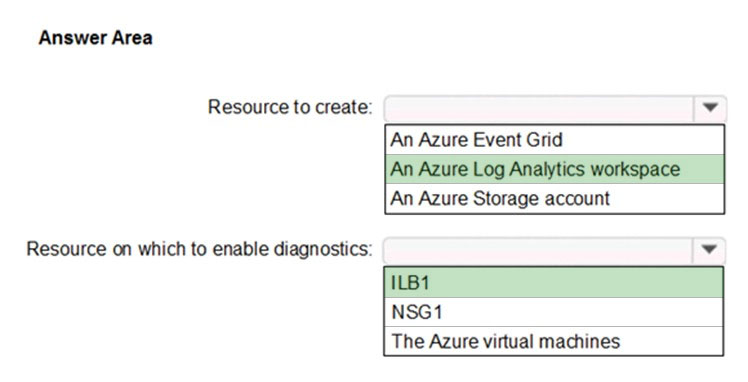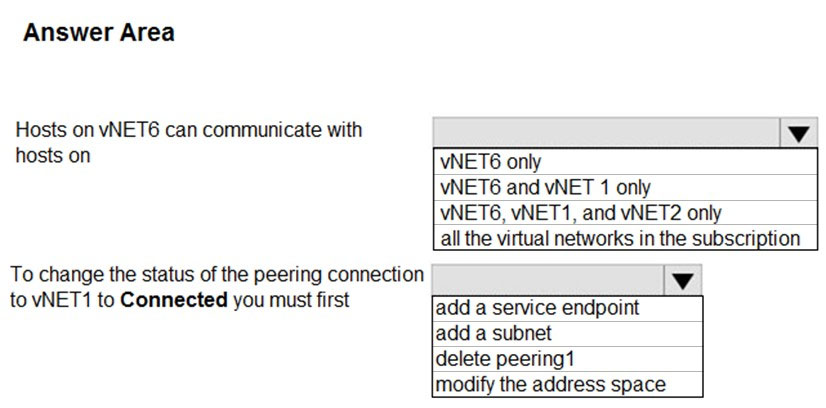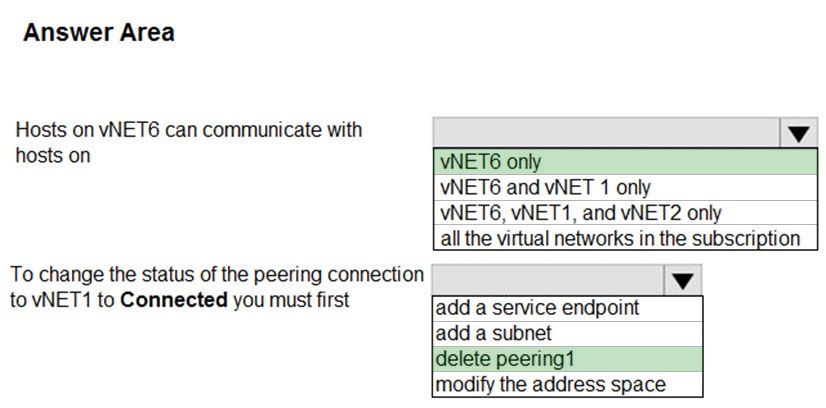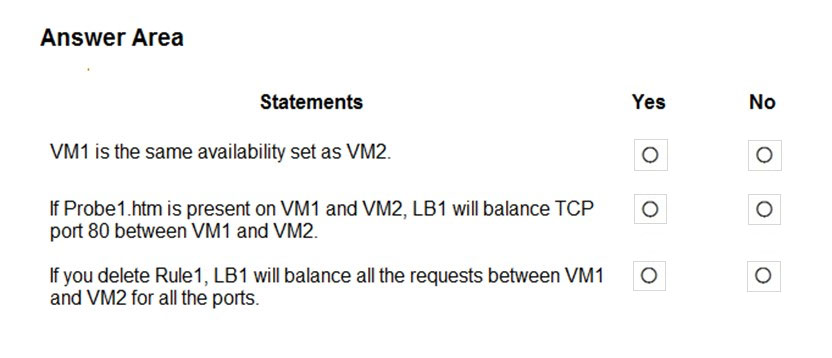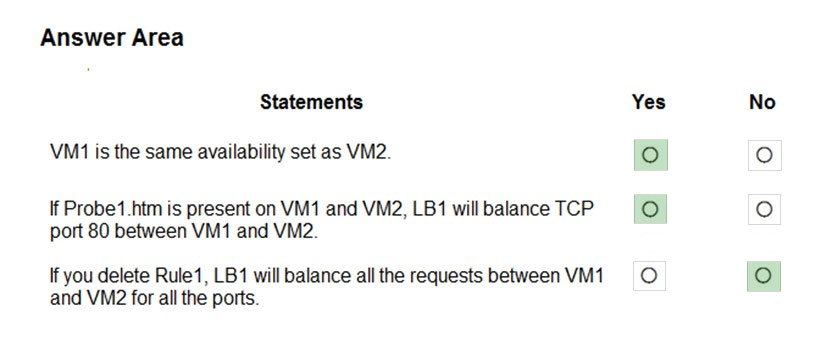AZ-103 Mock Test Free – 50 Realistic Questions to Prepare with Confidence.
Getting ready for your AZ-103 certification exam? Start your preparation the smart way with our AZ-103 Mock Test Free – a carefully crafted set of 50 realistic, exam-style questions to help you practice effectively and boost your confidence.
Using a mock test free for AZ-103 exam is one of the best ways to:
- Familiarize yourself with the actual exam format and question style
- Identify areas where you need more review
- Strengthen your time management and test-taking strategy
Below, you will find 50 free questions from our AZ-103 Mock Test Free resource. These questions are structured to reflect the real exam’s difficulty and content areas, helping you assess your readiness accurately.
You need to move the blueprint files to Azure. What should you do?
A. Use Azure Storage Explorer to copy the files.
B. Use the Azure Import/Export service.
C. Generate a shared access signature (SAS). Map a drive, and then copy the files by using File Explorer.
D. Generate an access key. Map a drive, and then copy the files by using File Explorer.
HOTSPOT - You have an Azure subscription named Subscription1. You plan to deploy an Ubuntu Server virtual machine named VM1 to Subscription1. You need to perform a custom deployment of the virtual machine. A specific trusted root certification authority (CA) must be added during the deployment. What should you do? To answer, select the appropriate options in the answer area. NOTE: Each correct selection is worth one point. Hot Area:
You have an Azure subscription named Subscription1. Subscription1 contains the resource groups in the following table.RG1 has a web app named WebApp1. WebApp1 is located in West Europe. You move WebApp1 to RG2. What is the effect of the move?
A. The App Service plan for WebApp1 moves to North Europe. Policy2 applies to WebApp1.
B. The App Service plan for WebApp1 remains in West Europe. Policy2 applies to WebApp1.
C. The App Service plan for WebApp1 moves to North Europe. Policy1 applies to WebApp1.
D. The App Service plan for WebApp1 remains in West Europe. Policy1 applies to WebApp1.
After you answer a question in this section, you will NOT be able to return to it. As a result, these questions will not appear in the review screen. You manage a virtual network named VNet1 that is hosted in the West US Azure region. VNet1 hosts two virtual machines named VM1 and VM2 that run Windows Server. You need to inspect all the network traffic from VM1 to VM2 for a period of three hours. Solution: From Azure Network Watcher, you create a packet capture. Does this meet the goal?
A. Yes
B. No
You have two Azure virtual networks named VNet1 and VNet2. VNet1 contains an Azure virtual machine named VM1. VNet2 contains an Azure virtual machine named VM2. VM1 hosts a frontend application that connects to VM2 to retrieve data. Users report that the frontend application is slower than usual. You need to view the average round-trip time (RTT) of the packets from VM1 to VM2. Which Azure Network Watcher feature should you use?
A. IP flow verify
B. Connection monitor
C. NSG flow logs
D. Connection troubleshoot
You download an Azure Resource Manager template based on an existing virtual machine. The template will be used to deploy 100 virtual machines. You need to modify the template to reference an administrative password. You must prevent the password from being stored in plain text. What should you create to store the password?
A. an Azure Key Vault and an access policy
B. a Recovery Services vault and a backup policy
C. Azure Active Directory (AD) Identity Protection and an Azure policy
D. an Azure Storage account and an access policy
You have five Azure virtual machines that run Windows Server 2016. The virtual machines are configured as web servers. You have an Azure load balancer named LB1 that provides load balancing services for the virtual machines. You need to ensure that visitors are serviced by the same web server for each request. What should you configure?
A. Idle Time-out (minutes) to 20
B. Floating IP (direct server return) to Disabled
C. Floating IP (direct server return) to Enabled
D. Session persistence to Client IP and protocol
E. a health probe
HOTSPOT - You have an Azure subscription named Subscription1 that has a subscription ID of c276fc76-9cd4-44c9-99a7-4fd71546436e. You need to create a custom RBAC role named CR1 that meets the following requirements: ✑ Can be assigned only to the resource groups in Subscription1 ✑ Prevents the management of the access permissions for the resource groups ✑ Allows the viewing, creating, modifying, and deleting of resource within the resource groups What should you specify in the assignable scopes and the permission elements of the definition of CR1? To answer, select the appropriate options in the answer area. NOTE: Each correct selection is worth one point. Hot Area:
HOTSPOT - You plan to deploy 20 Azure virtual machines by using an Azure Resource Manager template. The virtual machines will run the latest version of Windows Server 2016 Datacenter by using an Azure Marketplace image. You need to complete the storageProfile section of the template. How should you complete the storageProfile section? To answer, select the appropriate options in the answer area. NOTE: Each correct selection is worth one point. Hot Area:
HOTSPOT - You have an Azure subscription named Subscription1. You plan to deploy an Ubuntu Server virtual machine named VM1 to Subscription1. You need to perform a custom deployment of the virtual machine. A specific trusted root certification authority (CA) must be added during the deployment. What should you do? To answer, select the appropriate options in the answer area. NOTE: Each correct selection is worth one point. Hot Area:
You have an Azure subscription named Subscription1 that contains an Azure virtual network named VM1. VM1 is in a resource group named RG1. VM1 runs services that will be used to deploy resources to RG1. You need to ensure that a service running on VM1 can manage the resources in RG1 by using the identity of VM1. What should you do first?
A. From the Azure portal, modify the Access control (IAM) settings of RG1.
B. From the Azure portal, modify the Policies settings of RG1.
C. From the Azure portal, modify the Access control (IAM) settings of VM1.
D. From the Azure portal, modify the value of the Managed Service Identity option for VM1.
You have an Azure subscription named Subscription1. You deploy a Linux virtual machine named VM1 to Subscription1. You need to monitor the metrics and the logs of VM1. What should you use?
A. the AzurePerformanceDiagnostics extension
B. Azure HDInsight
C. Linux Diagnostic Extension (LAD) 3.0
D. Azure Analysis Services
You need to recommend a solution to automate the configuration for the finance department users. The solution must meet the technical requirements. What should you include in the recommendation?
A. Azure AD B2C
B. Azure AD Identity Protection
C. an Azure logic app and the Microsoft Identity Management (MIM) client
D. dynamic groups and conditional access policies
You are troubleshooting a performance issue for an Azure Application Gateway. You need to compare the total requests to the failed requests during the past six hours. What should you use?
A. NSG flow logs in Azure Network Watcher
B. Metrics in Application Gateway
C. Connection monitor in Azure Network Watcher
D. Diagnostics logs in Application Gateway
After you answer a question in this section, you will NOT be able to return to it. As a result, these questions will not appear in the review screen. You manage a virtual network named VNet1 that is hosted in the West US Azure region. VNet1 hosts two virtual machines named VM1 and VM2 that run Windows Server. You need to inspect all the network traffic from VM1 to VM2 for a period of three hours. Solution: From Azure Network Watcher, you create a connection monitor. Does this meet the goal?
A. Yes
B. No
DRAG DROP - You have an Azure Linux virtual machine that is protected by Azure Backup. One week ago, two files were deleted from the virtual machine. You need to restore the deleted files to an on-premises computer as quickly as possible. Which four actions should you perform in sequence? To answer, move the appropriate actions from the list of actions to the answer area and arrange them in the correct order. Select and Place:
You have an azure subscription named Subscription1 that has the following providers registered: ✑ Authorization ✑ Automation ✑ Resources ✑ Compute ✑ KeyVault ✑ Network ✑ Storage ✑ Billing ✑ Web Subscription1 contains an Azure virtual machine named VM1 that has the following configurations: ✑ Private IP address: 10.0.0.4 (dynamic) ✑ Network security group (NSG): NSG1 ✑ Public IP address: None ✑ Availability set: AVSet ✑ Subnet: 10.0.0.0/24 ✑ Managed disks: No ✑ Location: East US You need to record all the successful and failed connection attempts to VM1. Which three actions should you perform? Each correct answer presents part of the solution. NOTE: Each correct selection is worth one point.
A. Create an Azure Storage account.
B. Register the Microsoft.Insights resource provider.
C. Add an Azure Network Watcher connection monitor.
D. Enable Azure Network Watcher in the East US Azure region.
E. Enable Azure Network Watcher flow logs.
F. Register the Microsoft.LogAnalytics provider.
HOTSPOT - You are evaluating the name resolution for the virtual machines after the planned implementation of the Azure networking infrastructure. For each of the following statements, select Yes if the statement is true. Otherwise, select No. Hot Area:
After you answer a question in this section, you will NOT be able to return to it. As a result, these questions will not appear in the review screen. You manage a virtual network named VNet1 that is hosted in the West US Azure region. VNet1 hosts two virtual machines named VM1 and VM2 that run Windows Server. You need to inspect all the network traffic from VM1 to VM2 for a period of three hours. Solution: From Performance Monitor, you create a Data Collector Set (DCS). Does this meet the goal?
A. Yes
B. No
You plan to back up an Azure virtual machine named VM1. You discover that the Backup Pre-Check status displays a status of Warning. What is a possible cause of the Warning status?
A. VM1 is stopped.
B. VM1 does not have the latest version of WaAppAgent.exe installed.
C. VM1 has an unmanaged disk.
D. A Recovery Services vault is unavailable.
After you answer a question in this section, you will NOT be able to return to it. As a result, these questions will not appear in the review screen. Your company registers a domain name of contoso.com. You create an Azure DNS zone named contoso.com, and then you add an A record to the zone for a host named www that has an IP address of 131.107.1.10. You discover that Internet hosts are unable to resolve www.contoso.com to the 131.107.1.10 IP address. You need to resolve the name resolution issue. Solution: You add an NS record to the contoso.com Azure DNS zone. Does this meet the goal?
A. Yes
B. No
HOTSPOT - You need to meet the connection requirements for the New York office. What should you do? To answer, select the appropriate options in the answer area. NOTE: Each correct selection is worth one point. Hot Area:
You have an Azure subscription named Subscription1 that contains an Azure Log Analytics workspace named Workspace1. You need to view the error events from a table named Event. Which query should you run in Workspace1?
A. Get-Event Event | where {$_.EventType “”eq “error”}
B. Get-Event Event | where {$_.EventType == “error”}
C. search in (Event) * | where EventType “”eq “error”
D. search in (Event) “error”
E. select *from Event where EventType == “error”
F. Event | where EventType is “error”
HOTSPOT - You have an Azure subscription named Subscription1. Subscription1 contains the resources in the following table.In Azure, you create a private DNS zone named adatum.com. You set the registration virtual networks to VNet2. The adatum.com zone is configured as shown in the following exhibit.
For each of the following statements, select Yes if the statement is true. Otherwise, select No. NOTE: Each correct selection is worth one point. Hot Area:
HOTSPOT - You have an Azure subscription named Subscription1 that has a subscription ID of c276fc76-9cd4-44c9-99a7-4fd71546436e. You need to create a custom RBAC role named CR1 that meets the following requirements: ✑ Can be assigned only to the resource groups in Subscription1 ✑ Prevents the management of the access permissions for the resource groups ✑ Allows the viewing, creating, modifying, and deleting of resource within the resource groups What should you specify in the assignable scopes and the permission elements of the definition of CR1? To answer, select the appropriate options in the answer area. NOTE: Each correct selection is worth one point. Hot Area:
SIMULATION - Please wait while the virtual machine loads. Once loaded, you may proceed to the lab section. This may take a few minutes, and the wait time will not be deducted from your overall test time. When the Next button is available, click it to access the lab section. In this section, you will perform a set of tasks in a live environment. While most functionality will be available to you as it would be in a live environment, some functionality (e.g, copy and paste, ability to navigate to external websites) will not be possible by design. Scoring is based on the outcome of performing the tasks stated in the lab. In other words, it doesn't matter how you accomplish the task, if you successfully perform it, you will earn credit for that task. Labs are not timed separately, and this exam may have more than one lab that you must complete. You can use as much time as you would like to complete each lab. But, you should manage your time appropriately to ensure that you are able to complete the lab(s) and all other sections of the exam in the time provided. Please note that once you submit your work by clicking the Next button within a lab, you will NOT be able to return to the lab. You may now click next to proceed to the lab. Use the following login credentials as needed: Azure Username: XXXXXXX - Azure Password: XXXXXXX - The following information is for technical support purposes only: Lab Instance: 9172796 -Your company plans to store several documents on a public website. You need to create a container named bios that will host the documents in the storagelod9272261 storage account. The solution must ensure anonymous access and must ensure that users can browse folders in the container. What should you do from the Azure portal?
HOTSPOT - You have an Azure virtual network named VNet1 that connects to your on-premises network by using a site-to-site VPN. VNet1 contains one subnet named Subnet1. Subnet1 is associated to a network security group (NSG) named NSG1. Subnet1 contains a basic internal load balancer named ILB1. ILB1 has three Azure virtual machines in the backend pool. You need to collect data about the IP addresses that connects to ILB1. You must be able to run interactive queries from the Azure portal against the collected data. What should you do? To answer, select the appropriate options in the answer area. NOTE: Each correct selection is worth one point. Hot Area:
HOTSPOT - You have peering configured as shown in the following exhibit.Use the drop-down menus to select the answer choice that completes each statement based on the information presented in the graphic. NOTE: Each correct selection is worth one point. Hot Area:
After you answer a question in this section, you will NOT be able to return to it. As a result, these questions will not appear in the review screen. You have an Azure subscription named Subscription1. Subscription1 contains a resource group named RG1. RG1 contains resources that were deployed by using templates. You need to view the date and time when the resources were created in RG1. Solution: From the RG1 blade, you click Deployments. Does this meet the goal?
A. Yes
B. No
HOTSPOT - You are creating an Azure load balancer. You need to add an IPv6 load balancing rule to the load balancer. How should you complete the Azure PowerShell script? To answer, select the appropriate options in the answer area. NOTE: Each correct selection is worth one point. Hot Area:
After you answer a question in this section, you will NOT be able to return to it. As a result, these questions will not appear in the review screen. You have an Azure subscription that contains 10 virtual networks. The virtual networks are hosted in separate resource groups. Another administrator plans to create several network security groups (NSGs) in the subscription. You need to ensure that when an NSG is created, it automatically blocks TCP port 8080 between the virtual networks. Solution: You configure a custom policy definition, and then you assign the policy to the subscription. Does this meet the goal?
A. Yes
B. No
HOTSPOT - You have an Azure virtual machine named VM1 that connects to a virtual network named VNet1. VM1 has the following configurations: ✑ Subnet 10.0.0.0/24 ✑ Availability set: AVSet ✑ Network security group (NSG): None ✑ Private IP address: 10.0.0.4 (dynamic) ✑ Public IP address: 40.90.219.6 (dynamic) You deploy a standard, Internet-facing load balancer named slb1. You need to configure slb1 to allow connectivity to VM1. Which changes should you apply to VM1 as you configure slb1? To answer, select the appropriate options in the answer area. NOTE: Each correct selection is worth one point. Hot Area:
You need to define a custom domain name for Azure AD to support the planned infrastructure. Which domain name should you use?
A. ad.humongousinsurance.com
B. humingousinsurance.onmicrosoft.com
C. humongousinsurance.com
D. humongousinsurance.local
HOTSPOT - You have an Azure subscription. You plan to use Azure Resource Manager templates to deploy 50 Azure virtual machines that will be part of the same availability set. You need to ensure that as many virtual machines as possible are available if the fabric fails or during servicing. How should you configure the template? To answer, select the appropriate options in the answer area. NOTE: Each correct selection is worth one point. Hot Area:
After you answer a question in this section, you will NOT be able to return to it. As a result, these questions will not appear in the review screen. You have an Azure Active Directory (Azure AD) tenant named Adatum and an Azure Subscription named Subscription1. Adatum contains a group named Developers. Subscription1 contains a resource group named Dev. You need to provide the Developers group with the ability to create Azure logic apps in the Dev resource group. Solution: On Dev, you assign the Contributor role to the Developers group. Does this meet the goal?
A. Yes
B. No
You have an Azure DNS zone named adatum.com. You need to delegate a subdomain named research.adatum.com to a different DNS server in Azure. What should you do?
A. Create an A record named *.research in the adatum.com zone.
B. Create a PTR record named research in the adatum.com zone.
C. Modify the SOA record of adatum.com.
D. Create an NS record named research in the adatum.com zone.
You have an Azure virtual network named VNet1 that contains a subnet named Subnet1. Subnet1 contains three Azure virtual machines. Each virtual machine has a public IP address. The virtual machines host several applications that are accessible over port 443 to user on the Internet. Your on-premises network has a site-to-site VPN connection to VNet1. You discover that virtual machines can be accessed by using the Remote Desktop Protocol (RDP) from the Internet and from the on-premises network. You need to prevent RDP access to the virtual machines from the Internet, unless the RDP connection is established from the on-premises network. The solution must ensure that all the applications can still be accesses by the Internet users. What should you do?
A. Create a deny rule in a network security group (NSG) that is linked to Subnet1.
B. Modify the address space of Subnet1.
C. Modify the address space of the local network gateway.
D. Remove the public IP addresses from the virtual machines.
After you answer a question in this section, you will NOT be able to return to it. As a result, these questions will not appear in the review screen. You have an Azure Active Directory (Azure AD) tenant named Adatum and an Azure Subscription named Subscription1. Adatum contains a group named Developers. Subscription1 contains a resource group named Dev. You need to provide the Developers group with the ability to create Azure logic apps in the Dev resource group. Solution: On Subscription1, you assign the Logic App Operator role to the Developers group. Does this meet the goal?
A. Yes
B. No
You have a virtual network named VNet1 as shown in the exhibit. (Click the Exhibit tab.)No devices are connected to VNet1. You plan to peer VNet1 to another virtual network named VNet2 in the same region. VNet2 has an address space of 10.2.0.0/16. You need to create the peering. What should you do first?
A. Create a subnet on VNet1 and VNet2.
B. Add a gateway subnet to VNet1.
C. Modify the address space of VNet1.
D. Configure a service endpoint on VNet2.
DRAG DROP - You have an Azure Linux virtual machine that is protected by Azure Backup. One week ago, two files were deleted from the virtual machine. You need to restore the deleted files to an on-premises computer as quickly as possible. Which four actions should you perform in sequence? To answer, move the appropriate actions from the list of actions to the answer area and arrange them in the correct order. Select and Place:
HOTSPOT - You have an Azure subscription named Subscription1 that contains a resource group named RG1. In RG1, you create an internal load balancer named LB1 and a public load balancer named LB2. You need to ensure that an administrator named Admin1 can manage LB1 and LB2. The solution must follow the principle of least privilege. Which role should you assign to Admin1 for each task? To answer, select the appropriate options in the answer area. NOTE: Each correct selection is worth one point. Hot Area:
HOTSPOT - You have an Azure subscription that contains the resources in the following table. You install the Web Server server role (IIS) on VM1 and VM2, and then add VM1 and VM2 to LB1. LB1 is configured as shown in the LB1 exhibit. (Click the Exhibit tab.)Rule1 is configured as shown in the Rule1 exhibit. (Click the Exhibit tab.)
For each of the following statements, select Yes if the statement is true. Otherwise, select No. NOTE: Each correct selection is worth one point. Hot Area:
HOTSPOT - You have an Azure subscription named Subscription1. Subscription1 contains two Azure virtual machines named VM1 and VM2. VM1 and VM2 run Windows Server 2016. VM1 is backed up daily by Azure Backup without using the Azure Backup agent. VM1 is affected by ransomware that encrypts data. You need to restore the latest backup of VM1. To which location can you restore the backup? To answer, select the appropriate options in the answer area. NOTE: Each correct selection is worth one point. Hot Area:
SIMULATION - Please wait while the virtual machine loads. Once loaded, you may proceed to the lab section. This may take a few minutes, and the wait time will not be deducted from your overall test time. When the Next button is available, click it to access the lab section. In this section, you will perform a set of tasks in a live environment. While most functionality will be available to you as it would be in a live environment, some functionality (e.g, copy and paste, ability to navigate to external websites) will not be possible by design. Scoring is based on the outcome of performing the tasks stated in the lab. In other words, it doesn't matter how you accomplish the task, if you successfully perform it, you will earn credit for that task. Labs are not timed separately, and this exam may have more than one lab that you must complete. You can use as much time as you would like to complete each lab. But, you should manage your time appropriately to ensure that you are able to complete the lab(s) and all other sections of the exam in the time provided. Please note that once you submit your work by clicking the Next button within a lab, you will NOT be able to return to the lab. You may now click next to proceed to the lab.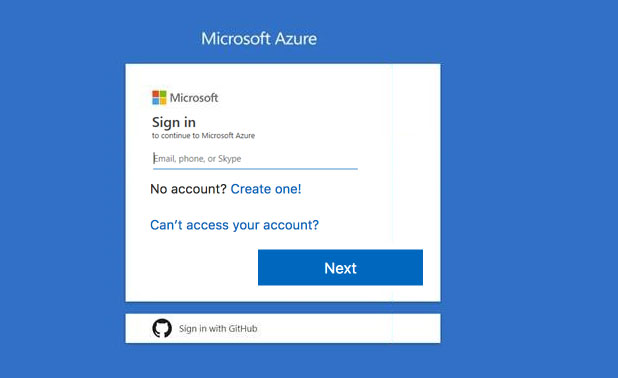
You plan to create several virtual machines in different availability zones, and then to configure the virtual machines for load balanced connections from the Internet. You need to create an IP address resource named ip1006 to support the planned load balancing solution. The solution must minimize costs. What should you do from the Azure portal?
HOTSPOT - You have an Azure subscription named Subscription1 that has a subscription ID of c276fc76-9cd4-44c9-99a7-4fd71546436e. You need to create a custom RBAC role named CR1 that meets the following requirements: ✑ Can be assigned only to the resource groups in Subscription1 ✑ Prevents the management of the access permissions for the resource groups ✑ Allows the viewing, creating, modifying, and deleting of resource within the resource groups What should you specify in the assignable scopes and the permission elements of the definition of CR1? To answer, select the appropriate options in the answer area. NOTE: Each correct selection is worth one point. Hot Area:
You have an Azure virtual machine named VM1. The network interface for VM1 is configured as shown in the exhibit. (Click the Exhibit tab.)You deploy a web server on VM1, and then create a secure website that is accessible by using the HTTPS protocol. VM1 is used as a web server only. You need to ensure that users can connect to the website from the internet. What should you do?
A. Create a new inbound rule that allows TCP protocol 443 and configure the protocol to have a priority of 501.
B. For Rule5, change the Action to Allow and change the priority to 401.
C. Delete Rule1.
D. Modify the protocol of Rule4.
After you answer a question in this section, you will NOT be able to return to it. As a result, these questions will not appear in the review screen. You have an Azure subscription that contains the following resources: ✑ A virtual network that has a subnet named Subnet1 ✑ Two network security groups (NSGs) named NSG-VM1 and NSG-Subnet1 ✑ A virtual machine named VM1 that has the required Windows Server configurations to allow Remote Desktop connections NSG-Subnet1 has the default inbound security rules only. NSG-VM1 has the default inbound security rules and the following custom inbound security rule: ✑ Priority: 100 ✑ Source: Any ✑ Source port range: * ✑ Destination: * ✑ Destination port range: 3389 ✑ Protocol: UDP ✑ Action: Allow VM1 connects to Subnet1. NSG1-VM1 is associated to the network interface of VM1. NSG-Subnet1 is associated to Subnet1. You need to be able to establish Remote Desktop connections from the internet to VM1. Solution: You modify the custom rule for NSG-VM1 to use the internet as a source and TCP as a protocol. Does this meet the goal?
A. Yes
B. No
HOTSPOT - You have an Azure subscription named Subscription1 that has a subscription ID of c276fc76-9cd4-44c9-99a7-4fd71546436e. You need to create a custom RBAC role named CR1 that meets the following requirements: ✑ Can be assigned only to the resource groups in Subscription1 ✑ Prevents the management of the access permissions for the resource groups ✑ Allows the viewing, creating, modifying, and deleting of resource within the resource groups What should you specify in the assignable scopes and the permission elements of the definition of CR1? To answer, select the appropriate options in the answer area. NOTE: Each correct selection is worth one point. Hot Area:
HOTSPOT - You need to identify the storage requirements for Contoso. For each of the following statements, select Yes if the statement is true. Otherwise, select No. NOTE: Each correct selection is worth one point. Hot Area:
You have an Azure subscription named Subscription1 that contains an Azure Log Analytics workspace named Workspace1. You need to view the error events from a table named Event. Which query should you run in Workspace1?
A. search in (Event) * | where EventType “”eq “error”
B. search in (Event) “error”
C. select *from Event where EventType is “error”
D. Event | where EventType is “error”
Access Full AZ-103 Mock Test Free
Want a full-length mock test experience? Click here to unlock the complete AZ-103 Mock Test Free set and get access to hundreds of additional practice questions covering all key topics.
We regularly update our question sets to stay aligned with the latest exam objectives—so check back often for fresh content!
Start practicing with our AZ-103 mock test free today—and take a major step toward exam success!


